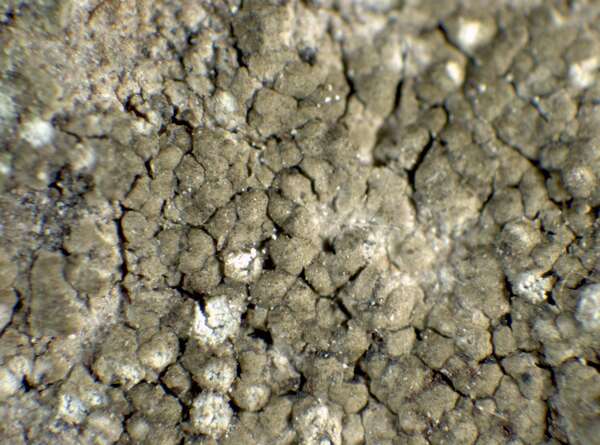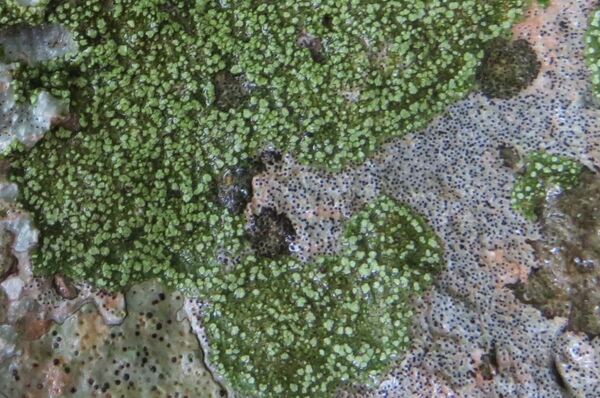Solenopsora olivacea subsp. olbiensis (Nyl.) Clauzade & Cl. Roux
in Roux, Bull. Soc. Bot. Centre-Ouest, n. sér. 13: 226, 1982. Basionym: Lecanora olbiensis Nyl. - Flora, 59: 306, 1876.
Synonyms: Catillaria olivacea var. soredifera Zahlbr.; Toninia olivacea var. olbiensis (Nyl.) Clauzade
Distribution: N - Lig (Guttová & al. 2014, 2019, Senko & al. 2024). C - Tosc (Guttová & al. 2014, 2019, Senko & al. 2024). S - Camp (Nimis & Tretiach 2004), Pugl (Durini & Medagli 2002), Bas (Nimis & Tretiach 1999, Guttová & al. 2019, Senko & al. 2024), Cal (Puntillo 1996, Senko & al. 2024), Si (Nimis & al. 1994, 1996b, Guttová & al. 2019, Senko & al. 2024).
Description: Thallus crustose, episubstratic, sorediate, green, brown-green, epruinose, forming irregular, sometimes confluent, up to 10 cm wide patches, the central part often warted-areolate, the marginal parts often minutely lobulate, with short, often not well-developed lobes. Soralia laminal, round, initially excavate, pale green, turning yellowish in the herbarium. Apothecia very rare, lecanorine, sessile, 0.3-0.7 mm across, with a pale to dark brown, flat to finally convex disc and a thin, poorly visible and often excluded thalline margin. Epithecium colourless to pale brown; hymenium colourless; paraphyses simple, coherent; hypothecium colourless. Asci 8-spored, cylindrical-clavate, with a K/I+ blue outer coat and a K/I+ uniformly blue apical dome, approaching the Catillaria-type. Ascospores 1-septate, hyaline, ellipsoid, 10-11 x 4-5 µm. Photobiont chlorococcoid. Spot tests: cortex K-, C-, KC-, P-; medulla P+ orange-red. Chemistry: medulla with pannarin and zeorin (both major).Note: on calciferous rocks, often associated with the typical subspecies, but rarer, and bound to more humid and shaded situations. A varietal rank is perhaps more appropriate.
Growth form: Crustose placodiomorph
Substrata: rocks
Photobiont: green algae other than Trentepohlia
Reproductive strategy: mainly asexual, by soredia, or soredia-like structures (e.g. blastidia)
Most common in areas with a humid-warm climate (e.g. most of Tyrrenian Italy)
Commonnes-rarity: (info)
Alpine belt: absent
Subalpine belt: absent
Oromediterranean belt: absent
Montane belt: absent
Submediterranean belt: absent
Padanian area: absent
Humid submediterranean belt: rather rare
Humid mediterranean belt: rare
Dry mediterranean belt: extremely rare

Predictive model
Herbarium samples
Growth form: Crustose placodiomorph
Substrata: rocks
Photobiont: green algae other than Trentepohlia
Reproductive strategy: mainly asexual, by soredia, or soredia-like structures (e.g. blastidia)
Most common in areas with a humid-warm climate (e.g. most of Tyrrenian Italy)
Commonnes-rarity: (info)
Alpine belt: absent
Subalpine belt: absent
Oromediterranean belt: absent
Montane belt: absent
Submediterranean belt: absent
Padanian area: absent
Humid submediterranean belt: rather rare
Humid mediterranean belt: rare
Dry mediterranean belt: extremely rare

Predictive model
| Herbarium samples |
 INDEX FUNGORUM
INDEX FUNGORUM
 GBIF
GBIF







